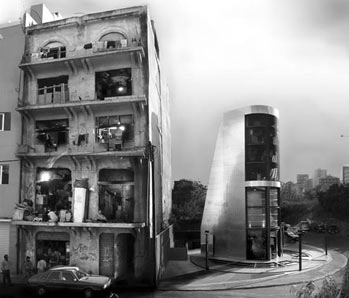March 17, 2009
By Leah Starr, Walter Cronkite School of Journalism
Lebanese architect Bernard Khoury defies the norm with his avant-garde designs, which he builds in response to what he calls the “total denial period” following the political and civil unrest in Lebanon.
In a dimly lit room of the Arizona State University Walter Cronkite School of Journalism in downtown Phoenix, Khoury addressed a crowd of over 200 recently as images of his past, current, and future projects were projected onto an overhead screen.

The American-educated architect introduced his theory of “Evolving Scars,” a sustainable concept of rehabilitating buildings that display traces of war and putting them to new uses, rather than demolishing them and denying their past.
During the post-war era in Beirut, a private company was commissioned to reconstruct the area and establish a positive, non-war affiliated identity for the city, said Khoury.
“But things were happening a bit too quickly,” said Khoury, “It was about erasing completely the scars of war.”
Determined to counter the annihilation of these sites scarred by destruction, Khoury deviated from the second-rate replicas taken from American models, said Khoury.
“All buildings look the same in Beirut,” said Khoury, “It is a continuous interpretation of bad building laws. American corporate machines build blindly these big buildings and they became the benchmark or model in Beirut.”
Khoury designed restaurant and bar, Centrale in 2001 by remaining faithful to the building’s natural decay.
According to Khoury’s website, the building was a former residential structure that was deserted during the civil war because of its close proximity to the line separating east and west Beirut.
Instead of re-plastering, Khoury chose to embrace the damaged exterior walls of the building by encasing the decomposing façade in a metallic wire mesh.
“It’s a poetry of decay,” said Khoury.
“I have an interest in his work of making something of this horrid destruction,” said audience member JoNette Rollene.
“I’m very interested in how the built environment changes your life and also, in urban conflicts,” said Bob Drehl, whose interest in Khoury’s aggressive designs was sparked after reading about his underground sushi bar, Yabani.
After his first project, a nightclub on the site of a former refugee camp that was later wiped out by Christian militias, Khoury received extensive publicity and was commissioned for projects ranging from a revolving residence, ultramodern banks and below-ground restaurants to a Saudi women’s day spa with a glass-block ceiling, futuristic nightclubs and a Kuwait shopping mall where the structure itself is encased in cascading waterfalls.
All projects boast lavish and extreme features, pushed to an almost absurd level, that cater to the rich, said Khoury.
“It’s a building for the rich, like everything I’ve built before,” said Khoury while clicking through the images of an elaborate Beirut residential structure, his first permanent project.
Before Khoury was commissioned to construct this building in 2006, his six previous projects were initially branded as temporary structures that would be used for public entertainment but would then face demolition.
“We are trained to think of buildings as a thing that remains once we’re gone and under the ground,” said Khoury, “They told me, ‘we’ll give you five to six years.”’
Though all of the temporary structures presented during the lecture have survived their five to six year predetermined fate, the majority of his projects has either been aborted or is on hold.
When asked if he has future plans or the desire to build on American soil, Khoury gives a slight chuckle.
“By the time the Americans understand me,” said Khoury, “I’ll be dead.”

